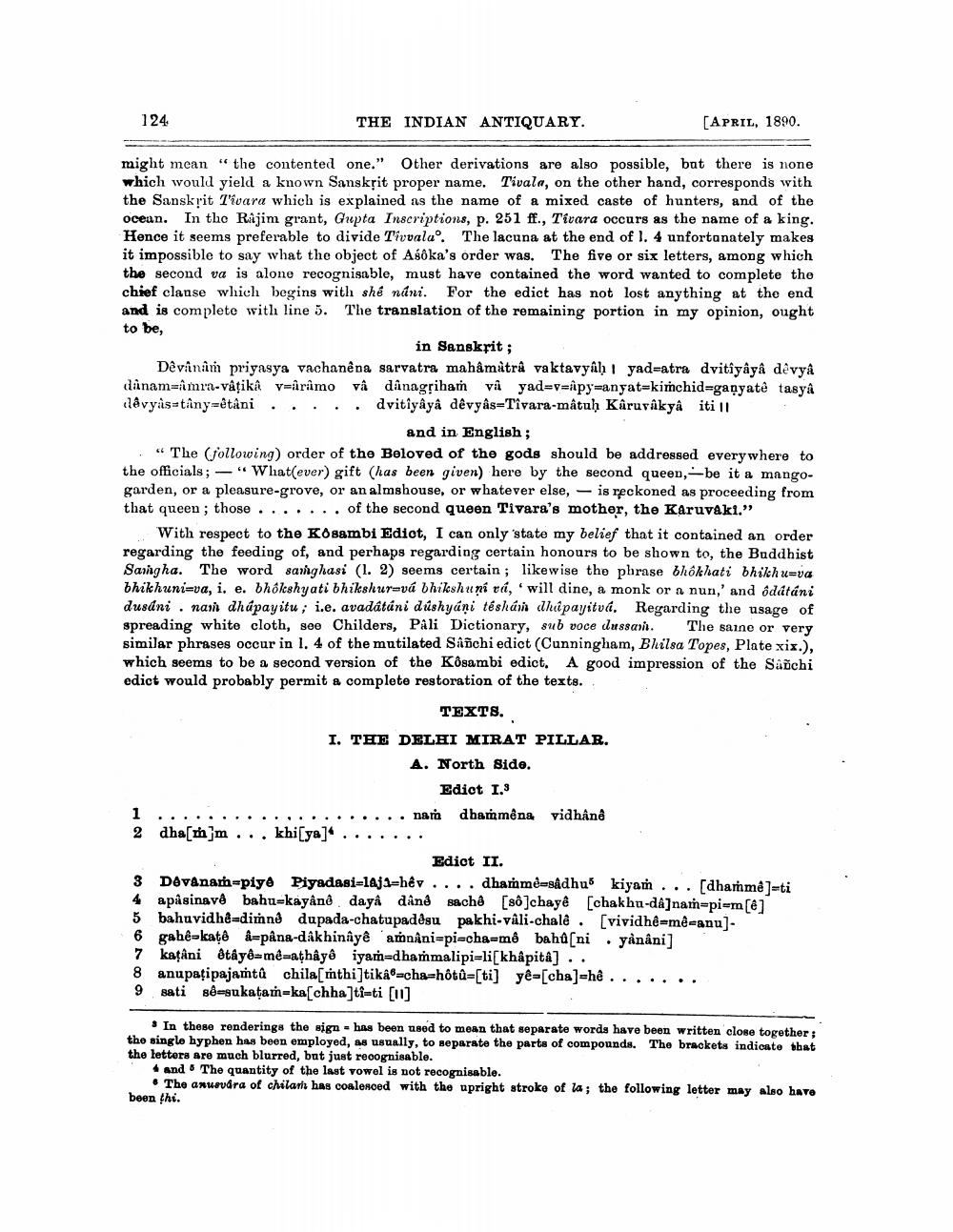________________
124
THE INDIAN ANTIQUARY.
[APRIL, 1890.
might mean “the contented one." Other derivations are also possible, but there is none which would yield a known Sanskțit proper name. Tivala, on the other hand, corresponds with the Sanskrit Tivara which is explained as the name of a mixed caste of hunters, and of the ocean. In tho Rajim grant, Grepta Inscriptions, p. 251 ff., Tivara occurs as the name of a king. Hence it seems preferable to divide Tivvala'. The lacuna at the end of l. 4 unfortonately makes it impossible to say what the object of Asoka's order was. The five or six letters, among which the second va is alone recognisable, must have contained the word wanted to complete the chief clanse which begins with she núni. For the edict has not lost anything at the end and is complete with line 5. The translation of the remaining portion in my opinion, ought to be,
in Sanskrit ; Devanan priyasya vachanêna sarvatra mahåmåtrå vaktavyâh | yadratra dvitiyâyâ devya dinamramra-vâţika yriramo vâ dânagriham va yad=v=ipywanyat-kinchid=ganyatê tasya clévyasətiny=etani ..... dvitiyâya dêvyâs=Tivara-matuh Karuvakya iti 11
and in English; .* The following) order of the Beloved of the gods should be addressed everywhere to the officials; -"Whatever) gift (has been given) here by the second queen, -be it a mangogarden, or a pleasure-grove, or an almshouse, or whatever else, - is reckoned as proceeding from that queen; those ....... of the second queen Tivara's mother, the Karuvaki."
With respect to the Kosambi Ediot, I can only 'state my belief that it contained an order regarding the feeding of, and perhaps regarding certain honours to be shown to, the Buddhist Saragha. The word sannghasi (1. 2) seems certain ; likewise the phrase bhokhati bhikhu=va bhikhuni=va, i. e. bhôkshyati bhikshuruvá bhikshuní vá,' will dine, a monk or a nun,' and ôdátáni dusani . nain dhápayitu ; i.e. avadátáni dilshyáni téshún ahapayitva. Regarding the usage of spreading white cloth, see Childers, Pali Dictionary, sub voce dussain. The saine or very similar phrases occur in l. 4 of the mutilated Sánchi edict (Cunningham, Bhilsa Topes, Plate xix.), which seems to be a second version of the Kosambi edict. A good impression of the Sabchi edict would probably permit a complete restoration of the texts.
TEXTS. I. THE DELHI MIRAT PILLAR.
A. North Side.
Edict 1.9 1 .................... nar dhammêna vidhanê 2 dha[mm... khi ya] .......
Edict II. 3 Dovanan-piye Piyadasi-1Aja-hêv.... dharme=sådhu kiyam... [dhammé]=ti 4 apasinavê bahu-kayanê dayê dând sachê [88]chayê [chakha-dâ]nar=pi-m[e] 5 bahuvidhê=dimnê dupada-chatupadègu pakhi-vali-chalê. [vividhê mêranu). 6 gahe-katê i=pana-dAkhinîyê anîni=pi-cha-mê bahů[ni . yânâni] 7 kafani tâyê=mê=athâyê iyam-dhammalipi=li(khôpita] .. 8 anupațipajantû chila[mthi]tika-cha-hôtů=[ti] yê-[cha)=hê ....... 9 sati sê=sukatam-ka(chhalti-ti [11]
In these renderings the sign - has been used to mean that separate words have been written close together; the singlo hyphen has been employed, as usually, to separate the parts of compounds. The brackets indicate that the letters are much blurred, but just recognisable.
4 and 5 The quantity of the last vowel is not recognisable.
• The anusdra of chilar has coalesced with the upright stroke of la; the following letter may also have been thi.




